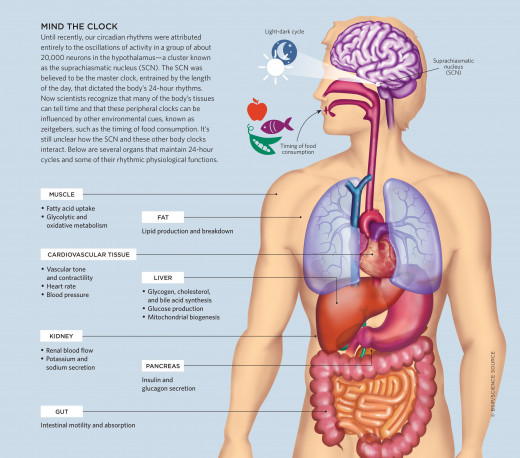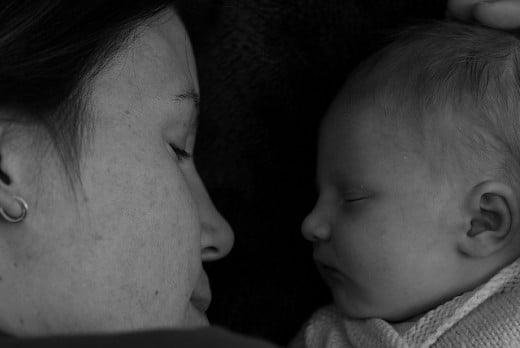Bodies in Swing - Interesting Facts About Body Rhythms

1. You can be out of sync with yourself
For a long time, it was believed that sleep-wake patterns were governed exclusively by a "master clock" located in a centre of our brain called the hypothalamus. But now it is recognized that many tissues in our bodies can tell their own time. These "peripheral clocks" can be influenced by clues from the environment, with a main one being food consumption.
The existence of different body clocks sheds new insight into connections that have been found between "abnormal" sleeping habits, as can be observed in shift workers, and a wide range of health problems, such as diabetes, obesity, heart conditions and depression.
“We suspect that eating at the inappropriate time of the day ends up with peripheral clocks—in the liver, in fat, in the pancreas, in the muscle—being in a phase which is now different from the [master clock in the brain, which mainly reacts to light],” says Georgios Paschos, a researcher at the University of Pennsylvania. This dissonance between the different clocks, according to him, can throw a body's entire energy system out of balance, and lead to disease.

Uri Hasson on TED: How meaning creates brain-brain synchrony
2. Rapport can be created using physiology
It has long been shown that people engaging in conversations unconsciously mimic each others movements. This includes eye blinks, head nods, gestures and the way they sit in chairs. The longer this takes place, the deeper the level of rapport.
Relatively new research shows, that, excitingly, not only does body-body synchrony increase during a social interaction, but so does brain-brain synchrony. This means that the brains of the participants in this research started to form one loose dynamic system. How much a person is able to synchronize their body and brain with another person is variable. For example, the researchers found that the participants who expressed the most social anxiety showed the smallest increase in synchrony during the experiment. Researchers have also started looking into how brain activities of participants are aligning in activities, like tango-dancing.
If you feel out of rapport with someone, you can jump start bonding by matching and mirroring someone else's behaviour or even physiology. So you can match and mirror not only someone's posture, head nods, or selection of words, but also subtly adjust your breathing pattern to their's. Breathing in unison can create a very strong sense of rapport, as any choir singer or yoga practitioner can confirm.

3. Mothers and their babies synchronize
If a baby should sleep in the mother's bed is a much-debated issue. If it does, some amazing mother-baby synchronization takes place. Firstly, they start orchestrating their movements in bed, spending most of the time facing each other. During her sleep, the mother will intervene protectively from time to time, to make sure the baby is comfortable and safe.
Mom and baby will also start to align their brain activity, heart rate, muscle tension and breathing rhythms, and they will cycle together through the different sleep phases, including dreaming and deep sleep.
The rhythmic stimulation the baby receives by being so close to the mother has been found to support the baby's brain maturation.
So what effects does this sleeping symbiosis have on sleep quality? From the baby's point of view, it is true that if they sleep in the same bed as their mothers, they will wake up more often during the night. But they go back to sleep more quickly (often by themselves), and cry less, ending up with overall less time awake during the night than their peers sleeping in their own beds.
Mothers in bed with their babies will experience less deep sleep, as they keep adjusting to the baby. But since the deep sleep and dreaming phases of the pair are co-ordinated, mothers are less often pulled from their deep sleep by a crying baby. And on average, they sleep as long as the mothers whose babies sleep on their own.
But what about the Sudden Infant Death Syndrome (SIDS)? Isn't it recommended that babies sleep in their own bed to prevent that? A BMJ article from 2013 maintains this position, even in optimal parental household conditions. The article was criticized, however, for lack of data and the conclusions drawn. A newer study does not condemn bed-sharing per se, but only if all of the following conditions are met:
- the mother is healthy (and not under the influence of alcohol, drugs, or sedatives)
- the mother and other people sleeping in the same room are non-smokers and
- the mother is breastfeeding (the synchrony described is markedly less developed if mothers are not breastfeeding)
- the baby was not born pre-term
Other advice valid for babies sleeping on their own, such as not overheating the room and avoiding very soft bedding, also apply to mothers and babies sleeping together.
Also see the excellent, up-to-date guide (2017) by UNICEF UK on co-sleeping.

4. Rhythms can heal
Because of the importance of rhythms in our daily lives and interactions, they are also used in therapeutic settings. Music therapy can improve physical, psychological and spiritual well-being, and is used in a wide setting of health problems, from linguistic and communicative deficits to depression. Social rhythm therapy concentrates on the rhythms of daily life, including sleeping patterns, and is used in bipolar disorders. Rhythmic inputs are also currently being studied to help the motor-skills of individuals suffering from autism.

5. Do women's menstrual cycles synchronize?
Do women’s menstrual cycles sync up over time if they are in close proximity to each other? Even though it is a very popular one, and, if you are a woman and lived together with other women for a while, you are very likely to believe it yourself - this is a myth.
The myth started with psychology research in 1971 at Harvard. But it now seems established that, if you account for the variations in cycle length (between 21-35 days), and a myriad of other things that affect the cycle, it all just comes down to chance.
You are adamant that you have experienced evidence to the contrary? Then have a look at the examples in this article. They show how easily coincidental effects can be misinterpreted.
© 2014 Sonja








